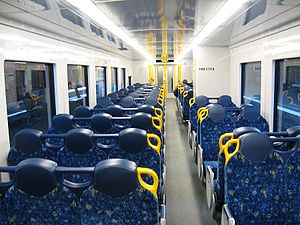New South Wales Hunter railcar
 From Wikipedia the free encyclopedia
From Wikipedia the free encyclopedia
| Hunter railcar | |
|---|---|
 2751 and 2701 in NSW TrainLink livery departing Sandgate | |
 Interior of a Hunter railcar in September 2007 | |
| In service | 2006–present |
| Manufacturer | UGL Rail |
| Built at | Broadmeadow |
| Replaced | 620/720 railcars |
| Constructed | 2006–2007 |
| Entered service | 23 November 2006 |
| Number built | 14 carriages (7 sets) |
| Number in service | 14 carriages (7 sets) |
| Formation | 2-car sets |
| Fleet numbers |
|
| Capacity | 77 (HM) 69 (HMT) |
| Operators | NSW TrainLink |
| Depots | Broadmeadow |
| Lines served | |
| Specifications | |
| Car body construction | Stainless steel with fibreglass end bonnets |
| Train length | 50.5 m (165 ft 8+3⁄16 in) |
| Car length | 25.25 m (82 ft 10+1⁄8 in) |
| Width | 2.93 m (9 ft 7+3⁄8 in) |
| Height | 4.24 m (13 ft 10+7⁄8 in) |
| Floor height | 1.27 m (4 ft 2 in) |
| Maximum speed |
|
| Weight |
|
| Prime mover(s) | Cummins QSK19-R |
| Power output | 559 kW (750 hp) |
| Transmission | Voith T312 bre |
| Auxiliaries | Cummins 6ISBe-G1 - 150 kW (201 hp) |
| Bogies | PKA (powered), NKA (trailer) |
| Coupling system | Dellner |
| Track gauge | 1,435 mm (4 ft 8+1⁄2 in) standard gauge |
The Hunter railcars,[1] are a class of diesel multiple unit operated by NSW TrainLink on the Hunter Line in New South Wales, Australia. Built by UGL Rail between November 2006 and September 2007, they initially operated for CityRail.
History[edit]

In 2001, the Government of New South Wales called for tenders for seven two-carriage railcar sets to replace the remaining 620/720 railcars on Hunter Line services, with a contract awarded to Goninan in 2002.[2][3][4]
Each set comprises two powered cars with one having a toilet.[5] The first set entered service on 23 November 2006, operating a small number of Newcastle to Telarah services on Thursday and Fridays only.[6] The second set entered service on 8 January 2007 also operating a limited number of services. By September 2007, all seven had entered service.[7] They operate services from Newcastle to Dungog and Scone alongside the Endeavours.
All sets passed from CityRail to NSW TrainLink with the Hunter line services in July 2013. In 2014/15, they received refurbished seats, improved toilet facilities, anti-graffiti interior paint and NSW TrainLink vinyls.[8]
Design[edit]


The design of the J sets is derived from the Transwa Prospector and AvonLink - the major difference being the driving cars are each single-engined instead of dual-engined, due to the lower top speed requirement for the Hunter line. Reversible seating is covered with durable, vandal proof woollen moquette fabric in 3x2 formation, and have retractable footrests. CCTV is installed. The cars have been fitted with Dellner SP couplers. They are able to absorb the impact of a collision, and the anti-climbers will also reduce the force of impact. They also have a different body design. Instead of the entire body being of the same design, such as the Tangara, the driver's cab is built as a protective cage, made of fibreglass, which stretches to the end of the guard's door. The stainless steel paneling starts at the guard's door. The guard's door is designed to operate separately from the passenger doors.
The trains have multiple-unit capability with the earlier Endeavour and Xplorers, but only in the event of failure or for empty coaching stock movements. These cars normally operate as two-car sets, however during peak periods they can operate as four-car sets.
Each car is powered by a Cummins QSK19-R diesel engine rated at 559 kW (750 hp) at 1800rpm coupled to a Voith T312bre hydraulic transmission driving both axles on one bogie via Voith SK-485 final drives. An auxiliary 150 kW (201 hp) Cummins 6ISBe-G1 diesel engine drives a Newage Stamford UCI274H alternator to supply power for the air conditioning and lighting.[9] Hunter Railcars are capable of 160 km/h (99 mph) but in service are limited to a maximum of 145 km/h (90 mph).[10]
References[edit]
- ^ NSW Trains 2013–14 Annual Report Page 7, Retrieved 24 November 2014
- ^ Market Railway Gazette International November 2001
- ^ Market Archived 3 August 2017 at the Wayback Machine Railway Gazette International November 2002
- ^ United Group wins OSC contract exceeding $150 million, with contract options to $450 million Archived 16 June 2017 at the Wayback Machine United Group
- ^ Hunter railcar Archived 12 June 2018 at the Wayback Machine Sydney Trains
- ^ New Hunter railcar goes into limited service CityRail 23 November 2006
- ^ Where to see our new trains CityRail
- ^ The NSW Government invests $5 million to overhaul Hunter train carriages Transport for New South Wales 29 April 2014
- ^ Hunter Rail Car Operating Instruction Manual. United Group Rail/RailCorp. 2006.
- ^ Hunter Rail Car UGL Rail
External links[edit]
![]() Media related to New South Wales Hunter railcars at Wikimedia Commons
Media related to New South Wales Hunter railcars at Wikimedia Commons